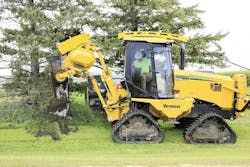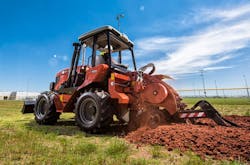Midsize ride-on trenchers are enjoying their day in the sun this year, especially those working in the communications and power sectors. Fitted with new technology and more capabilities, ride-on trenchers in the 49-to-127 horsepower range are ready to work in the tightest urban spots or on far-flung rural jobs.
Continuum Capital’s 2019 Telcom and Electric Outlook says growth in the electric transmission and distribution construction market is beginning an upward trajectory that will probably continue for the next 10 to 15 years, due in part to increasingly tough state and federal reliability and resilience requirements, along with increasing consumer demand. Both new and replacement construction segments are experiencing funding and spending acceleration in an effort to replace aging electric infrastructure for improved efficiency and reliability.
The push to bring high-speed Internet connectivity, especially in small towns and rural areas, is contributing to telcom construction. The Fiber Broadband Association (FBA) says fiber-to-the-home (FTTH) installations increased 19 percent in 2018. About 60 percent of that growth is underground, and FBA expects this same rate of growth to continue for the next three years. The fiber-construction segment should also see a significant bump as the rollout of 5G technology, predicted to be in full swing by 2023, picks up steam. In fact, the Telecommunications Industry Association (TIA) estimate calls for installation of 1,390,816 miles of fiber cable just to provide full 5G service to the top 25 metropolitan land areas in the United States.
Ditch Witch brand replaces Toro on ride-on trenchers. Read more here.
Construction growth will not be limited to the mega-providers such AT&T or Con Ed. Besides the regional carriers that blanket the country, there are more than 900 independent phone companies and 600 electric companies responsible for upgrading their systems.
Contractors anticipate the work. The Power & Communications Contractors Association (PCCA) surveyed its members this spring asking what they expect their workload to be in the next several years. Nearly 91 percent of respondents expect to see their workload increase more than 5 percent over the next three years, with 77 percent of those expecting increases of more than 10 percent. Over the next five years, 79 percent say their workload will likely increase more than 5 percent, with 47 percent of those expecting increases of more than 10 percent. Respondents said two-thirds of the growth will be new infrastructure. Contractors were also asked if they anticipate more overhead or underground work in the coming years. The repondents said they predict 79 percent of their jobs will be underground installations within seven years.
Contractors want tractors that accept a wide range of attachments, offer easier operator usability, “smart’ technology interfaces, and the ability to work in rural and urban terrain. Both Vermeer and Ditch Witch have new ride-on trenchers in their line ups this year that meet those requests.
“We’ve had a strong few years now,” says Ed Savage, Vermeer product manager for utility tractors. “For the last two years, water and new construction have been driving the trencher market.”
Savage says easier control interfaces and productivity technology are in demand. “The operator is under constant pressure to make operating adjustments all day long while trying to get the most footage completed in a day. Features like Vermeer’s Productivity Zone intelligent control system frees the operator from those tasks, reducing operator fatigue and increasing efficiency.”
The RTX1250i2 ride-on tractor intelligent control system, for example, optimizes production by preventing engine stalls when working in challenging ground conditions, according to Vermeer. The system’s TrenchSense actively monitors engine rpm while trenching and it will automatically pause the tractor’s forward creep if engine rpm drops or the trencher chain stops.
“Say you hit a rock or tree root that could stall out the digger chain,” Savage says. “In the past, the operator would have to react quickly. Now he can automatically stop the ground drive’s forward movement, back the machine up, start engaging the chain again, then start moving forward. The system helps things not to break, and the operator doesn’t have to restart the machine.”
Intelligent controls on the RTX1250i2 also include the EcoIdle engine control system that helps reduce fuel consumption by automatically lowering the engine’s speed to an idle if the tractor has not been active for 30 seconds. The Auto Plunge technology monitors engine rpm and reduces the rate of plunge automatically for a trencher or rockwheel attachment, maintaining rpm so it does not drop too far and kill the machine.
Switching out attachments will take less than an hour on the RTX1250i2 with its intelligent attachment feature, the company says. Vermeer’s i2 attachments communicate with the tractor’s machine control system to self-identify themselves, then adjust to match the operational needs of the attachment.
Being able to operate in tight spaces has been known to cause heartache for contractors. Chris Thompson, product manager for compact equipment and heavy duty trenchers for Ditch Witch, says the ability for tractors to make tight turns can make a world of difference on a job site.
The company recently updated the standard rear steering function on one of its ride-on trenchers. What used to be a manual process of turning a knob to control the back of the machine has been simplified through electronic rear steer. An LCD screen in the cab allows operators to see what their rear tires or tracks are doing and adjust them at the push of a button.
“The improvements with the electronic rear steer were made with the operator in mind,” Thompson said. “However, it’s in the attachments that most of the innovation is taking place.”
As the need for deploying fiber continues to increase, the need for microtrenching equipment rises in step. Ditch Witch offers a 12- and 16-inch microtrenching attachment for tractors. The MT12 is part of a complete microtrenching system, which includes the RT45, RT55 or RT80 trenchers and an HX75 vacuum excavator. The MT16 pairs with the RT55 and RT80 trenchers and
an HX75.
“All of the components for these complete microtrenching systems are designed and manufactured to work together with unbeatable efficiency,” Thompson said. “Both the MT12 and MT16 attachments create an ideal trench from 0.375 to 2 inches wide and allows contractors to install fiber shallower than other utilities with minimal disruption to the surrounding infrastructure.”






